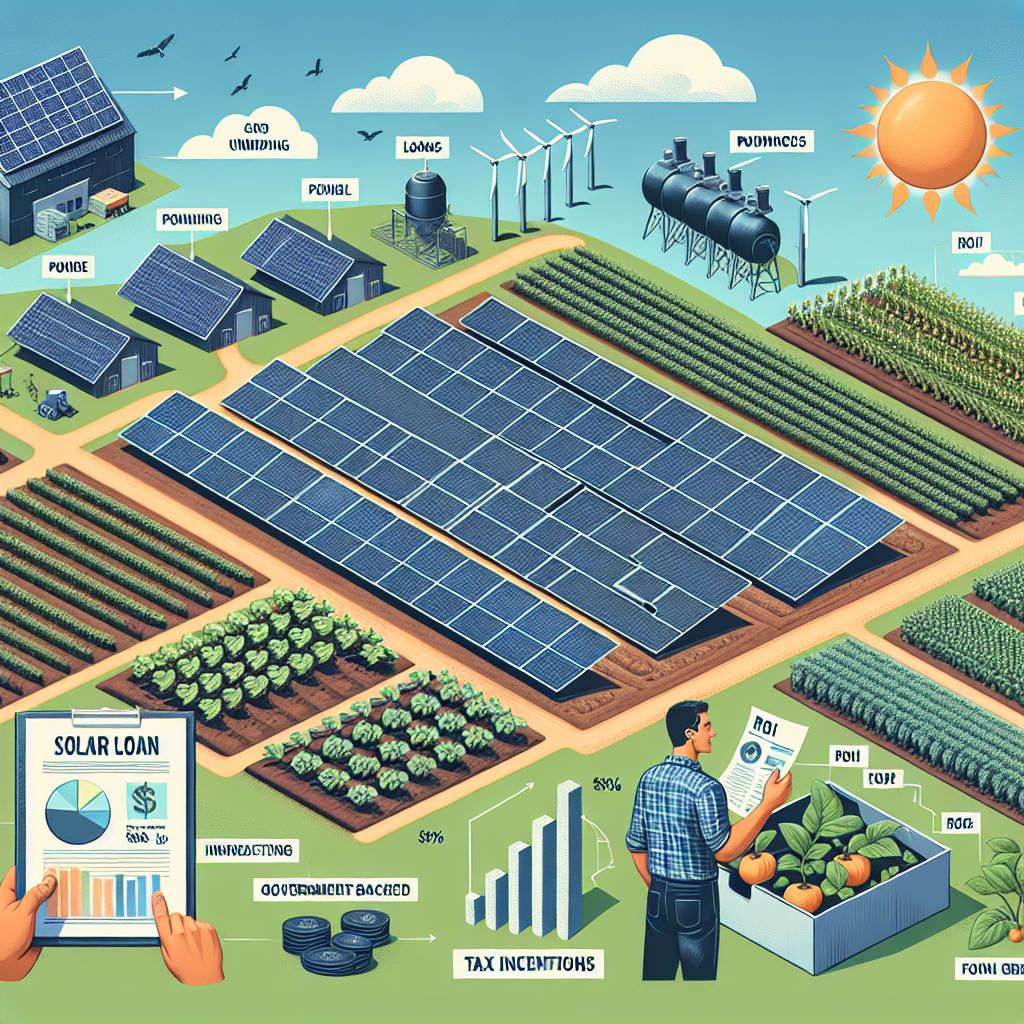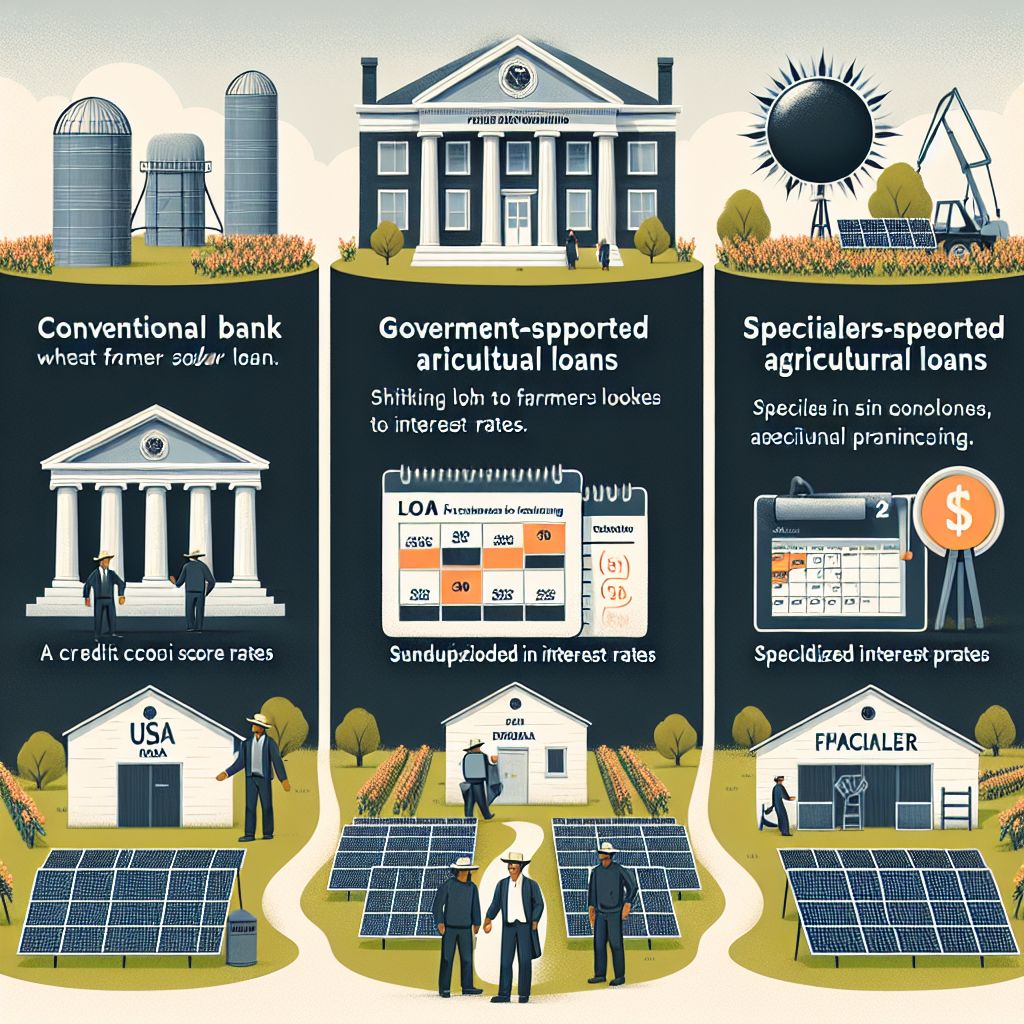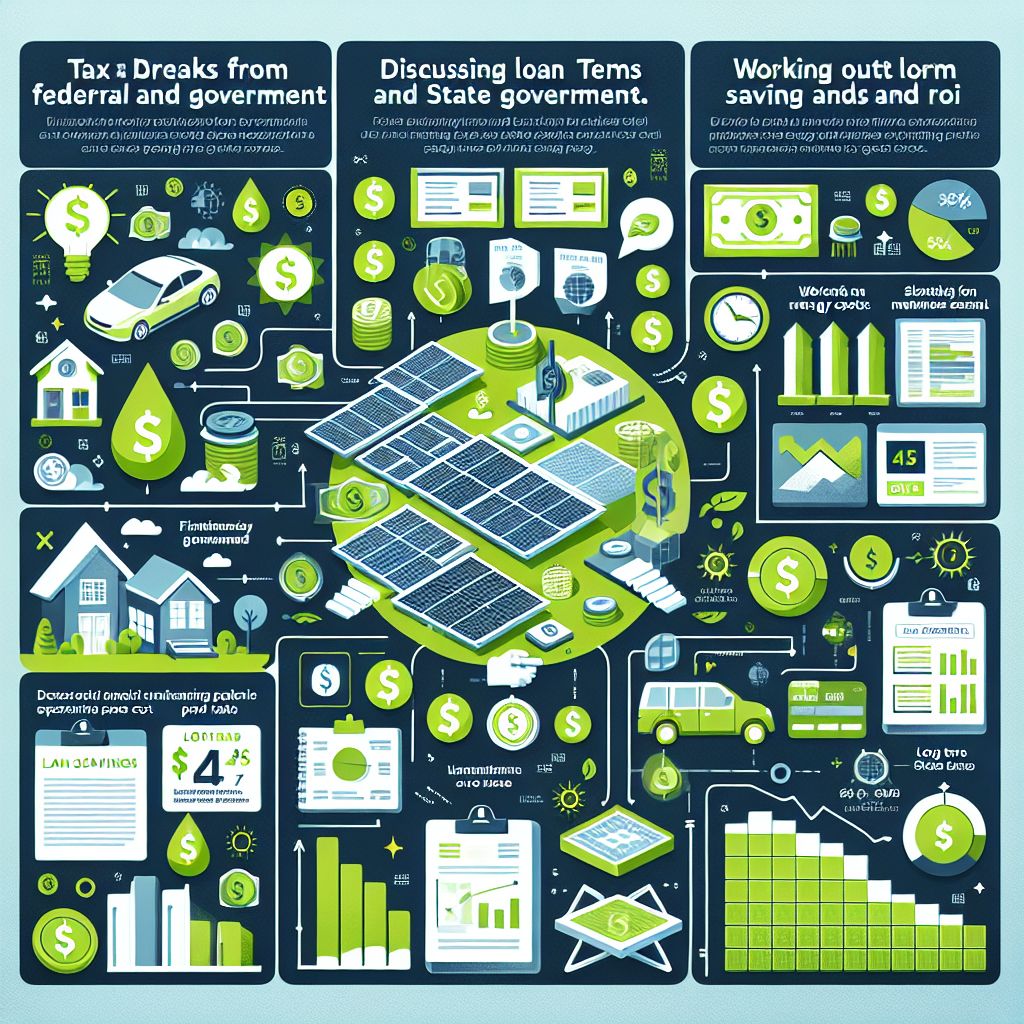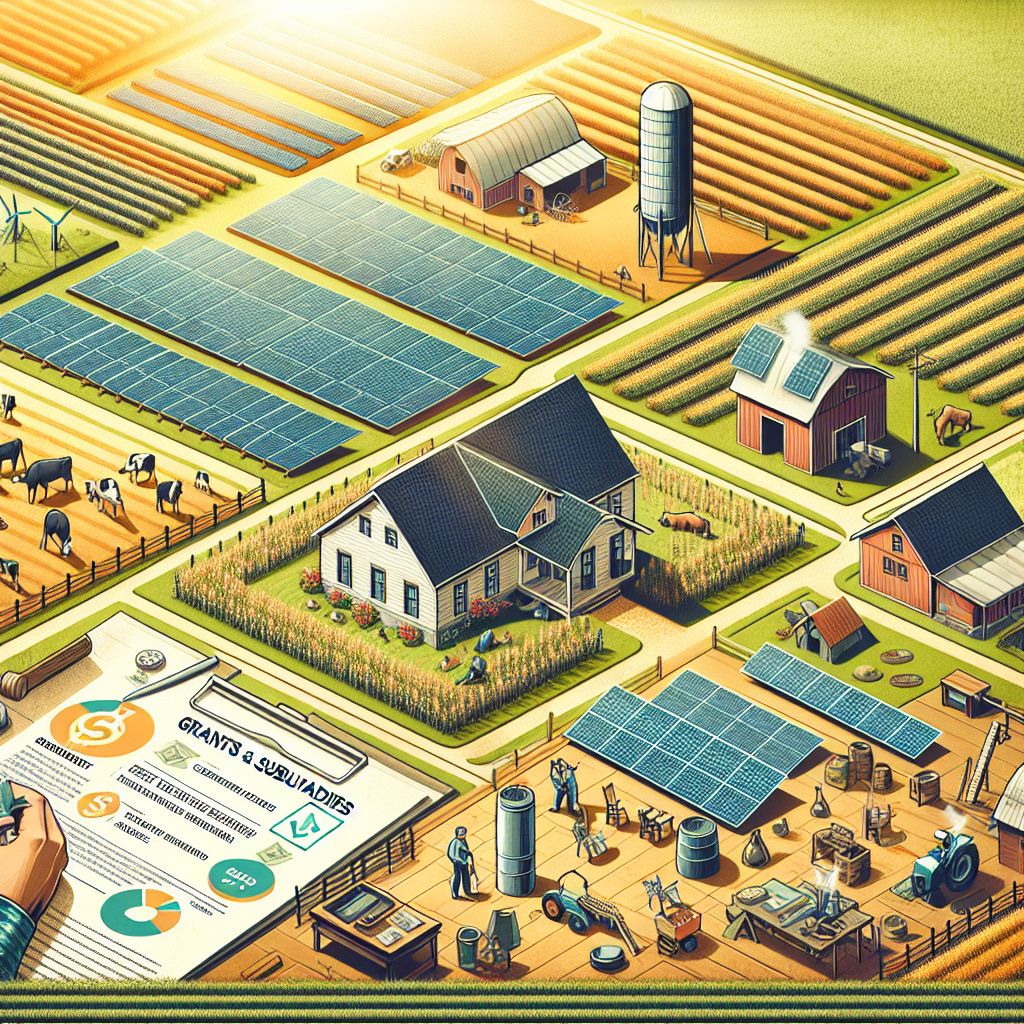
Key Takeaways
Looking into solar panel loans can greatly cut down on energy costs for farm irrigation systems.
Loans backed by the government and specialized solar financing options are available for farmers.
Tax incentives and grants can help to decrease the overall cost of solar panel installation.
Financing strategically can lead to long-term savings and a high return on investment (ROI).
Knowing your financing options and the benefits of solar energy is important to empower your farm financially.
Empowering Your Farm with Solar Energy
Farming is not just a lifestyle—it’s a business that needs smart investments to be successful. One of the most significant investments you can make today is in solar energy, especially for powering your farm’s irrigation system. Why? Because solar power is not just good for the environment; it’s great for your wallet over time.
Why Solar Power for a Farm’s Irrigation Makes Sense
Consider this. The sun is a massive source of energy, and it’s available for free. By using solar power, you can drastically reduce your electricity bills. Irrigation systems, which are crucial for a successful farm, can be one of the biggest users of energy. So, it’s not surprising that changing to solar can result in significant savings.
And there’s another thing. Solar power is dependable. It makes sure that your crops are watered as needed, even during power failures or peak demand periods when electricity costs skyrocket. Plus, as a farmer, you have the land—so why not use it to generate solar power?
First and foremost, choosing solar energy shows dedication to sustainable farming methods. It shows your clients and the public that you’re putting money into the future of farming and the world.
How Solar Energy Can Benefit Farmers Financially and Environmentally
Let’s take a closer look at the figures. Solar power could be a game-changer for your farm’s finances. The upfront costs might seem intimidating, but keep in mind, this is an investment that pays off. Solar panels usually last 25-30 years, so you’re looking at decades of reduced or even eliminated electricity bills.
The environmental impact is just as important. Solar energy is clean, renewable, and helps reduce your carbon footprint. This isn’t just beneficial for the planet; it’s also what more and more consumers are expecting from the businesses they patronize.
So, by going solar, you’re not only saving money; you’re also positioning your farm as a front-runner in sustainable agriculture. And with the increasing awareness around climate change, this is a strong position to take.

Getting to Know Your Solar Panel Loan Choices
So, you’re ready to go solar on your farm, but how are you going to pay for it? There are a number of loan options available to help farmers like you make the switch to renewable energy without emptying your wallet.
Conventional Bank Loans: Here’s What to Expect
Let’s start with conventional bank loans, which are frequently used to finance major purchases, such as solar panels. When you go to a bank, they’ll examine your credit score, financial history, and how profitable your farm is. The better these factors are, the better your loan conditions will be.
Here are some things to keep in mind when considering bank loans:
Interest Rates: Search for the best rates. Even a small difference can result in significant savings over time.
Repayment Terms: Longer terms might mean smaller monthly payments, but you’ll pay more in interest.
Collateral: Some loans might require you to put up assets as collateral. Be careful about what you’re willing to risk.
Keep in mind, the goal is to find a loan that you can comfortably pay back without putting a strain on your farm’s finances.
Agricultural Loans Supported by the Government
One of the best options to consider is government-backed loans. These are created to assist farmers and they often have better conditions than regular bank loans. The United States Department of Agriculture (USDA) provides a variety of loan programs that can be used for renewable energy projects, including the installation of solar panels for irrigation systems.
Here’s why these loans for solar irrigation systems are worth considering:
Subsidized Interest Rates: Government-backed loans typically come with lower interest rates, making them more affordable.
Payment Plans to Match Your Cash Flow: These loans often offer payment plans that align with the seasonal nature of farming.
Technical Assistance: These loans sometimes come with technical assistance and support to ensure the success of your renewable energy project.
These loans are a great fit for farmers looking to invest in solar energy because they are designed to promote rural development and sustainability.
Solar Financing Specialists
In addition to the usual banks and government loans, there are companies that specialize in financing solar energy projects. These companies have a deep understanding of the field and can offer solutions that are customized to your unique needs.
They usually provide:
Lower Interest Rates: They can usually offer better rates than banks because they focus on solar.
Efficient Operations: They can process loans faster and with less hassle because they are familiar with solar projects.
Professional Guidance: They can advise you on the best system for your farm and how to get the most out of your investment.
Working with a solar financing company that specializes in this area can make the switch to solar energy easier and ensure you get the best deal possible.
This below table will discuss the best loans to get solar panels for a farm’s irrigation system:
|
Loan Type |
Description |
Pros |
Cons |
|---|---|---|---|
|
Low-interest loans and grants from the USDA for renewable energy projects on farms |
Reduces upfront costs, favorable terms, supports sustainable agriculture |
Competitive application process, limited funding available | |
|
Home Equity Loan 2 |
Secured loan using your home’s equity as collateral |
Lower interest rates than unsecured loans, longer repayment terms |
Puts your home at risk if you default, closing costs can be high |
|
Unsecured personal loan from a bank, credit union, or online lender |
No collateral required, can be used for any solar project |
Higher interest rates than secured loans, shorter repayment terms | |
|
Financing offered by the solar installer, often through a third-party lender |
Lower rates and longer terms than personal loans, installer handles paperwork |
Rates and terms vary by installer, may be more expensive than shopping around | |
|
Contract where a third-party owns and operates the solar system on your property |
No upfront costs, fixed electricity rates for the contract term |
Requires long-term contract with third-party, don’t own the system | |
|
Renting the solar panels from a third-party owner |
No upfront costs, fixed electricity rates for the lease term |
Requires long-term contract, don’t own the system |

Boosting Savings with Smart Financing
After you’ve obtained financing for your solar panels, the next step is to boost your savings. This involves fully understanding and leveraging available tax incentives, negotiating the most favorable loan terms and rates, and figuring out your long-term savings and ROI.
Tax Breaks from the Federal and State Government
Our national government has a tax credit in place for solar energy systems, which can make a big dent in your initial investment cost. This credit lets you take a percentage of the cost of installing a solar energy system off your federal taxes. On top of this, many states have their own incentives, like rebates, tax breaks, or even grants.
Here’s what you have to do: consider the benefits of a solar irrigation system for your farm.
Investigate: Look into all available federal and state incentives. They can change from year to year, so make sure you have the latest information.
Apply: Ensure you meet all the eligibility requirements and apply for these incentives. Sometimes, the paperwork can be complex, so don’t hesitate to seek help from a professional if needed.
Plan: Incorporate these incentives into your financial planning to understand the true cost of your solar investment.
By leveraging tax incentives, you can significantly lower the upfront cost of going solar and speed up the return on your investment.
Discussing Loan Terms and Rates
It’s essential to negotiate the terms of your solar loan. You want to make sure you’re getting the best deal you can. Don’t just take the first offer; use it as a starting point to discuss better terms.
Here are some pointers:
Compare Lenders: Request quotes from various lenders to contrast interest rates and terms.
Emphasize Your Advantages: If you have a high credit score or a successful farm, utilize that as a bargaining chip in negotiations.
Request What You Need: Whether you want a lower interest rate or a longer repayment period, it’s always worth asking.
Keep in mind, lenders are seeking your business, so you have more control in this situation than you may believe.
This below table will go overs some tips for negotiating solar panel loan terms:
|
Tip |
Explanation |
Relevant Search Results |
|---|---|---|
|
Shop around with multiple lenders |
Compare interest rates, loan terms, fees, and credit score requirements from different lenders to get the best deal. | |
|
Negotiate origination fees |
Try to have origination fees waived or reduced, as they add to the total cost of the loan. | |
|
Avoid prepayment penalties |
Look for a lender that allows you to pay off the loan early without penalties so you can save on interest. | |
|
Opt for an unsecured loan |
Avoid secured loans that require collateral like your home or car. Opt for an unsecured personal loan instead. | |
|
Choose a comfortable loan term |
Shorter terms have lower interest but higher monthly payments. Longer terms have lower payments but pay more interest over time. Pick a term you can comfortably afford based on your budget. |
By negotiating the best possible terms, you can save money on interest and ensure your solar loan fits your financial situation. Don’t be afraid to shop around, ask questions, and advocate for yourself to get the most favorable deal.
Working Out Long-Term Savings and ROI
Going solar for your farm’s irrigation system isn’t just about the instant savings on your electricity bill. It’s also about the long-term financial gains. To truly grasp the effect of your investment, you need to work out your long-term savings and return on investment (ROI).
Think about this:
Energy Savings: Figure out how much energy your solar panels will create and how much money you’ll save over time.
Maintenance Costs: Solar panels don’t cost much to maintain, but they’re not free. Be sure to include these costs in your calculations.
System Lifespan: Solar panels can last for many years. The longer they last, the more money you’ll save.
Knowing your ROI will help you understand when your solar investment will begin to pay for itself and how much money it will save you in the long term.

Getting Past the Money Problem
For some farmers, the upfront price of solar panels can be a stumbling block. But don’t let money problems keep you from going solar. There are ways to get past these problems and still get the advantages of solar power.
Rent-to-Own Programs
Rent-to-own programs can be a fantastic way to begin using solar energy without a significant initial investment. You rent the solar panels for a set period, and at the end of the lease, you have the option to purchase them. During the lease, you can reap the benefits of the energy savings without the full commitment of purchasing the system outright.
Here’s the lowdown: If you’re considering solar panel loans for your farm’s irrigation system, it’s important to explore the best financing options and savings strategies to ensure cost-effectiveness and sustainability.
Monthly Payments: Usually, these payments are lower than what you’d pay for grid energy.
Maintenance: Often, the leasing company will take care of maintenance and repairs, reducing your workload.
Flexibility: When the lease ends, you have the option to buy the panels, renew the lease, or have them removed.
This option can provide a way to solar energy that fits with your farm’s cash flow and financial circumstances.
Government Grants and Subsidies for Solar Energy
Last but not least, consider grants and subsidies. These are funds provided by governments or organizations to help cover the cost of solar panel installation. Unlike loans, grants do not have to be repaid, which makes them an incredibly attractive option.
This is how you should tackle this chance:
Research: Look into what grants and subsidies are available in your local area. These can differ greatly, so having local knowledge is essential.
Eligibility: Check that you meet the eligibility criteria before applying. This can save you a lot of wasted time and effort.
Application: Grant applications can be competitive. Make sure your application is comprehensive and stands out from the rest.
Grants and subsidies can greatly reduce the financial burden of switching to solar power, making it a viable option for more farmers.
Final Thoughts
Solar panel loans can make solar-powered irrigation systems more affordable for farmers. By choosing the right financing option and implementing savings strategies, farmers can significantly reduce the cost and maximize the benefits of this sustainable technology. Access to reliable and cost-effective irrigation is essential for agricultural productivity and profitability, and solar panels present a promising solution for the future of farming.
Common Questions
Grasping the details of solar panel loans can assist you in making choices that promote the long-term success and viability of your farm.
Many agriculturalists have inquiries about the details of obtaining loans for solar panels for their irrigation systems. Here are a few of the most frequently asked questions:
How Much Does a Solar-Powered Irrigation System Cost Initially?
The initial cost of a solar-powered irrigation system can be influenced by a variety of factors, including the size of the system, the type of technology used, and the unique needs of your farm. While a broad estimate, you could be looking at spending anywhere from $20,000 to $1,000,000 for a full solar irrigation setup. However, this is just an estimate and your actual costs may be less or more.
When calculating the cost, you should consider not just the solar panels, but also the inverters, mounting systems, wiring, and installation. To get a more accurate estimate, it’s a good idea to request quotes from multiple solar installation companies. They can give you a more exact figure based on the specific needs of your farm.
How Do Solar Loans Impact My Farm’s Cash Flow?
Solar loans can impact your farm’s cash flow in a few ways. Initially, you may see an outflow of funds due to loan repayments. However, the savings on energy costs can quickly start to offset these payments. In fact, over time, the reduction in utility bills usually results in positive cash flow. It’s crucial to calculate your break-even point and plan your finances accordingly to ensure that loan repayments don’t put undue pressure on your farm’s operations.
What if I Don’t Have the Best Credit Score?
Don’t worry if your credit score isn’t the best. You can still apply for a solar loan. While you may get better interest rates with a higher credit score, there are still financing options for those with lower scores. Here’s what you can do:
Seek out lenders who focus on offering loans to those with less than stellar credit scores.
Government-backed loans might be a good option to consider, as they often have more lenient requirements.
Lease-to-own programs could also be worth exploring, as they typically don’t require traditional credit checks.
Keep in mind that showing the profitability of your farm and having a well-thought-out business plan can go a long way in persuading lenders to approve your loan.
What Are the Dangers of Financing a Solar Panel System?
Like any monetary obligation, financing a solar panel system presents certain dangers. These can include:
There is a risk that the solar system will not produce the anticipated amount of energy.
There is a financial risk if the energy savings do not cover the loan repayments as quickly as expected.
There are market risks such as changes in energy prices or government incentives.
However, these risks can be managed with thorough research, proper planning, and choosing reputable solar providers and financing partners.
When Can I Expect to See a Return on Investment?
The time it takes to see a return on investment (ROI) from a solar-powered irrigation system varies. It typically depends on factors like the size of the system, the cost of installation, the amount of sunlight your location receives, and the energy costs in your area. On average, farmers can expect to see an ROI within 5 to 10 years. However, with the right financing and incentives, some may achieve it sooner.







Leave a Reply